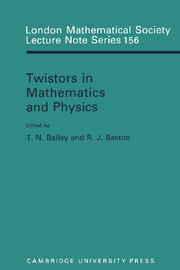Book contents
- Frontmatter
- Preface
- Contents
- 1 Twistor Theory After 25 Years—its Physical Status and Prospects
- 2 Between Integral Geometry and Twistors
- 3 Generalized Conformal Structures
- 4 Riemannian Twistor Spaces and Holonomy Groups
- 5 Twistors, Ambitwistors, and Conformal Gravity
- 6 The Penrose Transform
- 7 Notation for the Penrose Transform
- 8 The Twistor Transform
- 9 Invariant Operators
- 10 Penrose's Quasi-local Mass
- 11 The Sparling 3-form, Ashtekar Variables and Quasi-local Mass
- 12 Twistors and Strings
- 13 Integrable Systems in Twistor Theory
- 14 Twistor Characterization of Stationary Axisymmetric Solutions of Einstein's Equations
- 15 A Two-surface Encoding of Radiative Space-times
- 16 Twistors, Massless Fields and the Penrose Transform
- 17 Twistor Diagrams and Feynman Diagrams
- 18 Cohomology and Twistor Diagrams
- Authors' addresses
Preface
Published online by Cambridge University Press: 05 May 2013
- Frontmatter
- Preface
- Contents
- 1 Twistor Theory After 25 Years—its Physical Status and Prospects
- 2 Between Integral Geometry and Twistors
- 3 Generalized Conformal Structures
- 4 Riemannian Twistor Spaces and Holonomy Groups
- 5 Twistors, Ambitwistors, and Conformal Gravity
- 6 The Penrose Transform
- 7 Notation for the Penrose Transform
- 8 The Twistor Transform
- 9 Invariant Operators
- 10 Penrose's Quasi-local Mass
- 11 The Sparling 3-form, Ashtekar Variables and Quasi-local Mass
- 12 Twistors and Strings
- 13 Integrable Systems in Twistor Theory
- 14 Twistor Characterization of Stationary Axisymmetric Solutions of Einstein's Equations
- 15 A Two-surface Encoding of Radiative Space-times
- 16 Twistors, Massless Fields and the Penrose Transform
- 17 Twistor Diagrams and Feynman Diagrams
- 18 Cohomology and Twistor Diagrams
- Authors' addresses
Summary
Our aim in editing Twistors in Mathematics and Physics has been to collect together review articles which reflect the wide diversity of ideas and techniques which constitute modern twistor theory. Whilst the origins and much continuing work in twistor theory are in the area of fundamental physics, there is an ever-growing body of ‘twistor mathematics’ which has now taken on a life of its own. This is reflected this by articles on representation theory and differential geometry, among other subjects.
The main objective in the ‘twistor programme’ for fundamental physics is a theory which unites Einstein's general relativity and the world of quantum physics—a theory in which the rôle of complex holomorphic geometry is fundamental; Penrose's article in this volume reviews its current status. Other contributors have covered the advances which have ocurred since the major successes of Penrose's non-linear graviton and Ward's construction of the Yang-Mills instantons—the most notable of these is probably Penrose's definition of quasi-local mass in general relativity, and topics such as the twistor description of vacuum space-times with symmetries and twistor particle theory are also covered.
Twistor mathematics is now a wide-ranging subject in itself, and articles in this volume cover differential geometry, integrable systems and several topics related to representation theory. The process by which Penrose originally encoded solutions of field equations on Minkowski space in terms of holomorphic functions on regions in twist or space, namely the Penrose transform, has been generalized to a complex homogeneous spaces, and so has applications in the theory of invariant operators (Verma modules) and the construction of unitary representations. The reader will find all these topics, and others, covered here.
Information
- Type
- Chapter
- Information
- Twistors in Mathematics and Physics , pp. v - viPublisher: Cambridge University PressPrint publication year: 1990
